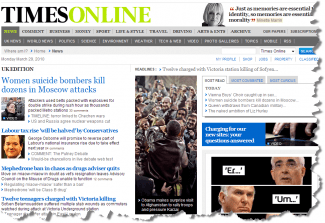 Readers of The Times online are going to have to dig into their piggy banks come June; The Times and The Sunday Times are to start charging for access to their websites. You will need to pay £1 a day or get it discounted to £2 a week. If you subscribe to the print edition – £6 a week – you get the online access free of charge. Is this commercial suicide? Almost certainly for a newspaper; yet for other businesses such charging models could do well.
Readers of The Times online are going to have to dig into their piggy banks come June; The Times and The Sunday Times are to start charging for access to their websites. You will need to pay £1 a day or get it discounted to £2 a week. If you subscribe to the print edition – £6 a week – you get the online access free of charge. Is this commercial suicide? Almost certainly for a newspaper; yet for other businesses such charging models could do well.
The problem that Rupert Murdoch faces is two-fold. Firstly, the circulation of The Times is plummeting. The latest figures, released in February, show that the newspaper is down 17% in the year since 2009. That’s the biggest drop of any national daily newspaper and compares with circulation increases for The Sun and The Star. The Sunday Times is down by almost 8% in the past year. With falls in circulation – and the resulting drop in income – there is also a reduction in advertising fees. Advertisers don’t like paying standard rate card fees when the circulation is falling; inevitably they negotiate the costs downwards too.
The second issue which faces Mr Murdoch is the increasing demand for online news. Indeed, The Times gets almost five times as many people reading the newspaper online than it does buying a newspaper. A recent study showed that people now prefer to access online news instead of physical newspapers. But with the plethora of online news sites, people are spoilt for choice. And that means if The Times charges, readers can simply opt for a free news site, including The BBC which has confirmed it will not charge for online news.
Clearly, the chances of success are not stacked in favour of The Times. They are stuck in an old-fashioned business model in which charging for news was acceptable – because that was the only way we could get it. But with Twitter, for instance, world news can be spread to millions of people the moment it happens and without any need for the costs of journalism. The old business model doesn’t work. For the newspaper industry, they need to think again. One possible model would be free online news and then access to the in-depth material published as a print magazine, or video material downloadable at cost, for example.
And therein lies the secret to how you can charge for your website. People are not prepared to pay for information they can get for nothing elsewhere. But they are prepared to pay for analysis and in-depth support which is specifically geared to their particular needs. The Guardian, for example, has hinted that this is the direction it will take – charging for in-depth analysis and special sections, rather than the general material which can be obtained anywhere for nothing.
Thousands of websites already exist using a subscriber model. But the basic set-up is always free. The paid-for material is then the specific, in-depth, analytical stuff that helps people improve their situation. So, what in-depth analysis can you provide your potential online customers?
With the “free” model for information so well-established online, you are only going to be able to charge for material that goes beyond what other websites provide. That’s the point that has eluded Mr Murdoch and his cronies. Don’t fall into the same trap, assuming that people will be happy to pay because of who you are. They won’t; they are only happy to pay online for highly targeted, in-depth and supportive analytical material they cannot find anywhere else. Your challenge, as ever, is to be unique.
